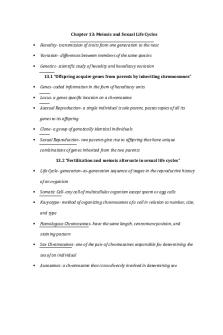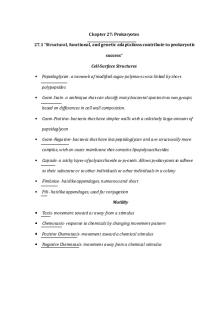Diffusion-Osmosis - Summary Campbell Biology PDF

| Title | Diffusion-Osmosis - Summary Campbell Biology |
|---|---|
| Author | Claudia Hernandez |
| Course | Biology for Science Majors I |
| Institution | Collin College |
| Pages | 3 |
| File Size | 183.3 KB |
| File Type | |
| Total Downloads | 79 |
| Total Views | 137 |
Summary
talks about animal and plant cells...
Description
Assignment 2
15pts
1. Describe how each of the following can affect membrane fluidity (2pts) -
decreasing temperature: as temperature cool, membrane switch from a fluid state to a solid state
-
phospholipids with unsaturated hydrocarbon chains; it increases fluidity brcause of more kinks. They are not packed as closely together.
-
cholesterol: at warm temperature (such as 37-degree C), cholesterol restrains movement of phospholipids. At a cool temperature, it maintains fluidity by preventing tight packing. they keep the cell membrane fluid so that it won’t solidify. increasing the number of saturated hydrocarbon tails; decreases fluidity because they are closely packed together.
-
2. Label the following components of an animal cell membrane on the figure (3pts)
a. Glycolipid b. Glycoprotein c. integral protein d. peripheral protein e. cholesterol f. cytoskeleton microfilaments
Glycoprotein Glycolipid
cholesterol
Microfilaments of cytoskeleton Peripheral proteins
Integral protein
3. Consider the following materials that must cross the membrane. For each, tell how it is moved across (simple diffusion/transport protein) (2pts) CO2 simple diffusion Glucose transport protein H+
transport protein
H2O
protein channels and simple suffusion
4. What is facilitated diffusion? Is it active or passive? (2pt) Facilitated diffusion Is the movement of specific molecules down a concentration gradient passing through the membrane via a specific carrier protein. And yes it is a passive and requires no energy from the cell.
5. Movement of water through the aquaporins is an example of active transport. (True/False) (1pt) False 6. How is a carrier protein different from a channel protein? (1pt)
The carrier protein does change its shape to move the substance while the channel does not. Channel just provides the channel but the carrier holds onto passengers. A carrier protein alternates between two shapes, moving a solute across the membrane during the shape change. A channel protein has a channel through which water molecules or a solution can pass.
7. Why does the red blood cell burst when placed in a hypotonic solution, but not the plant cell? (2pt) The plant cell has a cell wall around the outside which stops them from bursting. If the animal cell is placed in a hypotonic solution it will fill up with water and then burst. The plant cells are turgid (firm) and generally healthiest in a hypotonic environment where the uptake of water is eventually balanced by the wall pushing back on the cell.
8. Describe active transport. What type of transport proteins are involved, and what is the role of ATP in the process? (2pt) In active transport, the cell must expend energy to pump a solute across a membrane against its gradient. The trans port proteins that move the solutes against their concentration gradients are all carrier proteins rather than channel protein. ATP provides the required energy for active transport...
Similar Free PDFs

Ch26 - Summary Campbell Biology
- 6 Pages
Popular Institutions
- Tinajero National High School - Annex
- Politeknik Caltex Riau
- Yokohama City University
- SGT University
- University of Al-Qadisiyah
- Divine Word College of Vigan
- Techniek College Rotterdam
- Universidade de Santiago
- Universiti Teknologi MARA Cawangan Johor Kampus Pasir Gudang
- Poltekkes Kemenkes Yogyakarta
- Baguio City National High School
- Colegio san marcos
- preparatoria uno
- Centro de Bachillerato Tecnológico Industrial y de Servicios No. 107
- Dalian Maritime University
- Quang Trung Secondary School
- Colegio Tecnológico en Informática
- Corporación Regional de Educación Superior
- Grupo CEDVA
- Dar Al Uloom University
- Centro de Estudios Preuniversitarios de la Universidad Nacional de Ingeniería
- 上智大学
- Aakash International School, Nuna Majara
- San Felipe Neri Catholic School
- Kang Chiao International School - New Taipei City
- Misamis Occidental National High School
- Institución Educativa Escuela Normal Juan Ladrilleros
- Kolehiyo ng Pantukan
- Batanes State College
- Instituto Continental
- Sekolah Menengah Kejuruan Kesehatan Kaltara (Tarakan)
- Colegio de La Inmaculada Concepcion - Cebu














